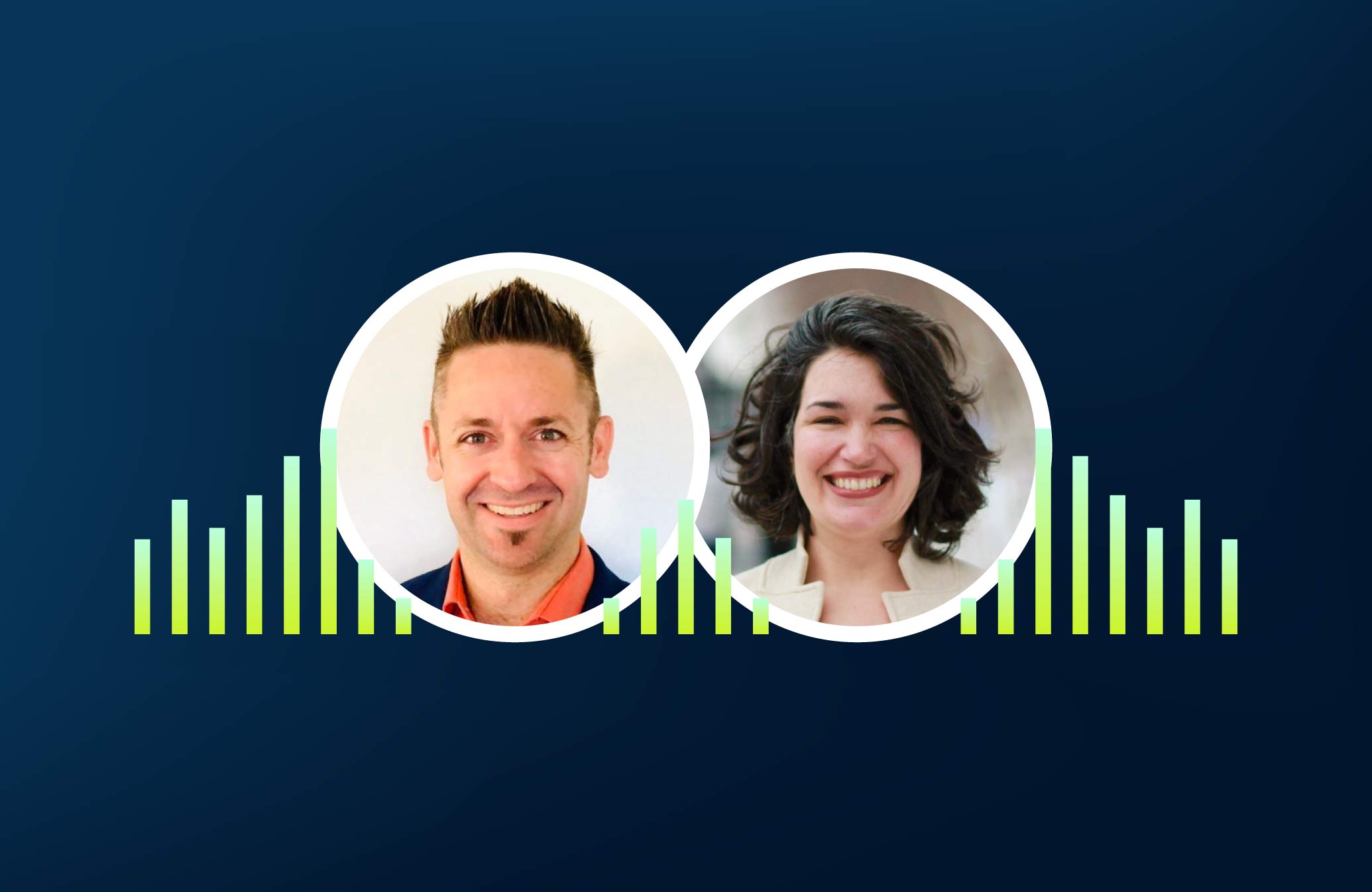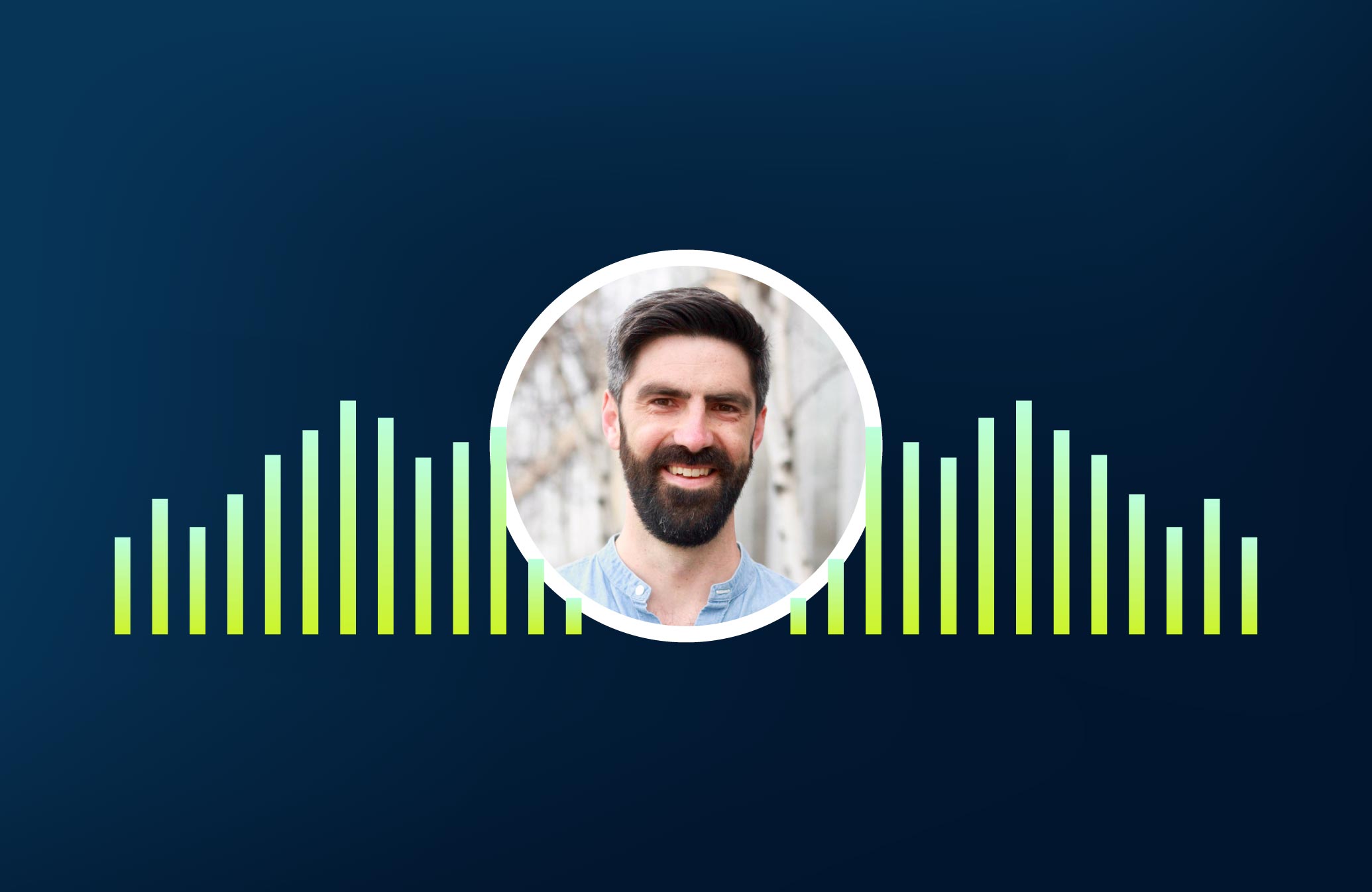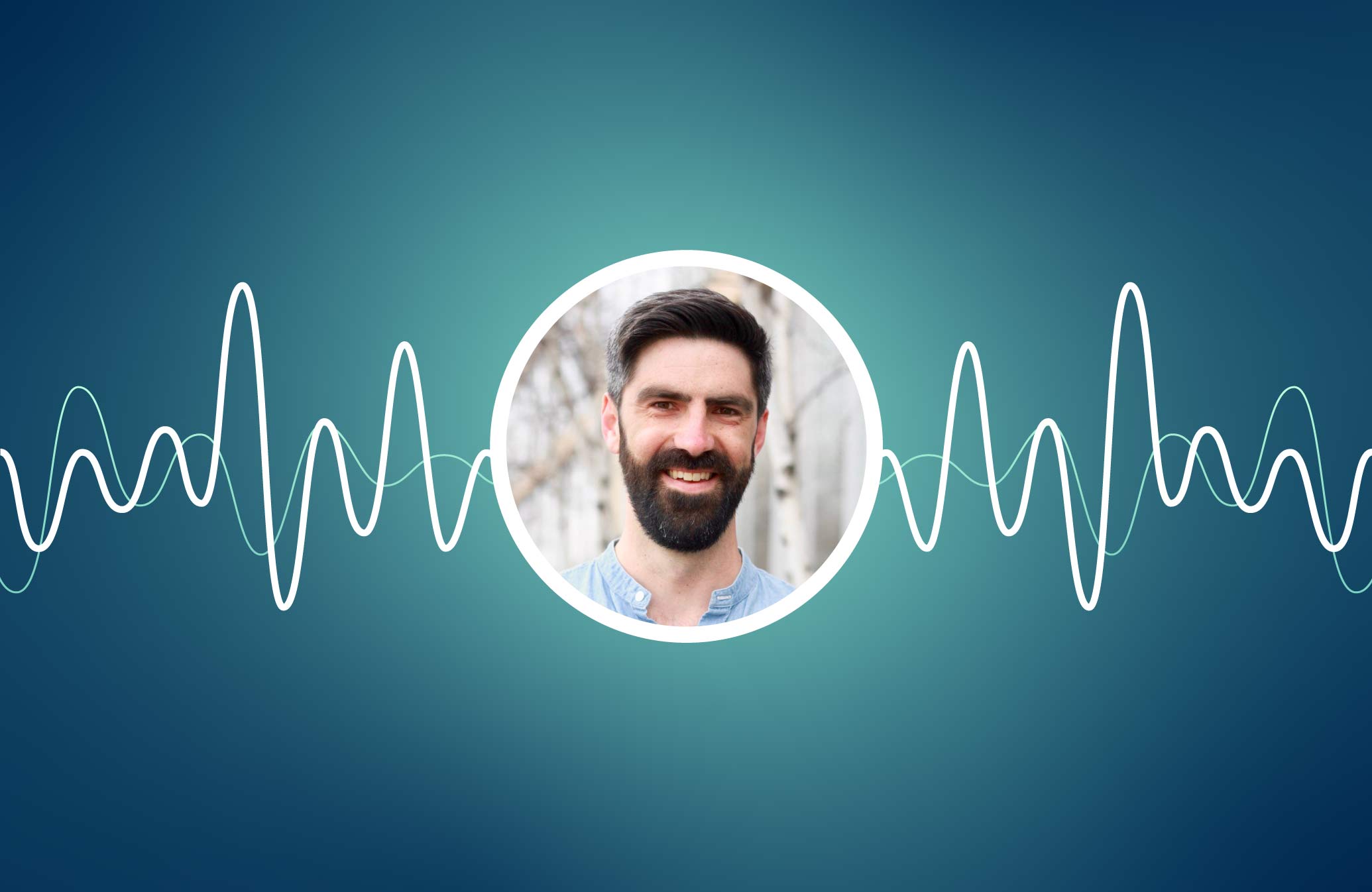Listen Now
Episode Transcript
Announcer [00:00:00] Welcome to RadioRev, podcasting from the heart of healthcare in Minneapolis, Minnesota. This is the podcast for change makers looking to do more than just health engagement. It’s about getting people to take action and do things that actually improve their health. It’s a radical idea, right? So we’re talking with the leaders, innovators, movers, and shakers who are bringing new ideas, inspiring others, and leading the way.
Jenn [00:00:26] Today, we are taking a week off from our Social Determinants of Health season for a special crossover episode with one of our favorite healthcare podcasts, Healthcare Rap. We’re joined by Jared Johnson, host of the Healthcare Rap podcast, and Louise Briguglio, SVP of Product and Development at Icario. Welcome to the show, guys.
Louise [00:00:42] Thanks, Jenn.
Jared [00:00:43] Thank you.
Jenn [00:00:44] I’m excited to have both of you here. And as always, we’re going to start with our housekeeping question. What’s your favorite ’80 song?
Jared [00:00:52] This was probably the hardest question of all of these things. I’m a music nut to begin with. And so just narrowing it down…I think I could only narrow it down to, like, about 40 songs. So I’m just picking one off of that playlist. And I’m going with kind of a sentimental favorite, which was “Where the Streets Have No Name” by U2 off of “The Joshua Tree” album, probably just because I can speak the most about that album. And it reminds me of one of the best concert experiences I’ve ever had, which was flying out from Phenix to the Rose Bowl in Pasadena, California, just a couple of years ago, where they did a 25th or 30th year tour for “The Joshua Tree.” They played the whole album from beginning to end, and they played out in the Rose Bowl. And at that point, they hadn’t announced any tour dates in Arizona. So my brother-in-law happens to be a pilot who gets free airfare. And he’s like, okay, hey, let’s go out to the Rose Bowl. And so we flew in that morning, hit the U2 concert at the Rose Bowl, which is a phenomenal concert venue, just so historic in every way, and then stayed overnight and flew back home the next morning. And it was just him and me and my sister, and a great experience. And so that just kind of reiterated to me when we got to hear that song “Where the Streets Have No Name,” which was the opening song of the album. It was just a lot of fun. So I think overall, I could go on and on, so I won’t, but a really fun song, and it reminds me a lot of growing up. {music plays}
Jenn [00:02:46] That’s awesome. I love that. Now, Louise, you’ve been on the show before, but you can either tell us your second-favorite ’80s song or your favorite ’90s song.
Louise [00:02:54] I will go with my second-favorite ’80s song, which would probably be Madonna’s “Like a Prayer.” So I’m not sure why, but for some unknown reason, the college I went to, which is Grinnell College, which is a very small college smack dab in the middle of Iowa, kind of chose that song to be its theme song. So at every party, that song came on at least once, and everyone stopped what they were doing and would sing it out loud together. So that one holds some sentimental value for me. {music plays}
Jenn [00:03:42] Thanks. So, Jared, let’s start with you. Can you introduce yourself, tell us a little bit about who you are, what you do, and more about your podcast?
Jared [00:03:51] Yeah. Thanks so much for coming up with this idea of this crossover episode. This is going to be a lot of fun. And one thing I like to do is connect with other podcasters like yourself because the stories that are being told are so important. And I’ve been learning that myself as I’ve been doing this. I’ve been podcasting since 2015, and I’ve learned a lot along the way. And that’s just one thing I’ve done. The Healthcare Rap is for challenging the status quo on healthcare, marketing, and technology. And those are some of the areas that I’ve come up in my career. I’ve been client side the majority of my career. And in the last few years, I’ve been consulting as a digital business strategist for healthcare organizations. I help them build brands, and podcasting has done more for me to stay aware of what’s going on, to kind of keep my finger on the pulse of things. And that’s why I enjoy it. I love connecting with folks like yourself and Louise and being able to just understand and hear what’s going on in the world in different industries. And so that’s where I am. I’m a consultant and podcaster.
Jenn [00:04:49] And Louise, do you want to tell us a little bit about your background and more about who you are?
Louise [00:04:54] So like Jenn mentioned, I’m leading product and technology here at Icario. I’m a bit biased, but we have a really great, pretty sophisticated product. There’s a lot of really talented people, designers, lots of user-centered designers, people who go out and do behavioral research. We have data scientists and analysts on my team, a lot of engineers, and it’s a really great group of people to work with. And I love the diversity of opinion and experience that everybody has. My personal background is in the user-centered design domain. So I studied in graduate school human-computer interaction, which really sounds much nerdier than it actually is. So it’s the intersection basically of technology, human behavior, psychology, and then design practices. And so I kind of fell in love with Icario at first sight, realizing that when you’re trying to use technology and digital media to engage people to health action, you really get to explore a lot of those domains pretty deeply in a pretty creative way.
Jenn [00:06:01] Awesome. Thanks for that background. So the whole reason that we’re here today is to talk about healthcare member experience. And I have a couple of launching off point questions. One is, why does this topic even matter, and why are we talking about it?
Louise [00:06:17] Yeah, that’s a that’s a great question, Jenn. You know, I think what a lot of our customers see and what we tend to see is that a feeling that healthcare in particular has really kind of lagged behind other industries in terms of how they communicate to their populations, how populations engage with communications. And then at the end of the day, the healthcare industry more than ever before, is really on the hook for people doing things based on those communications. Everyone’s sort of on the hook for outcomes now. So you’re communicating not just, say, for the sake of brand familiarity and positive sentiment, you’re communicating often because you’re really trying to get people to do things. So it feels more important than ever to understand how our populations, how our customers, view us as healthcare entities and to make sure that we understand how we need to speak to them in a way that does make them trust us, does make them feel good about our brand. But even further gets them to perform the kind of health actions we need them to do.
Jenn [00:07:23] You just alluded to the next question. It’s a perfect segue because generally speaking, healthcare has a reputation for not being a leader in member experience. Other industries seem to have this down. But why does it seem that healthcare can’t figure this out? How did the industry get this reputation in the first place?
Jared [00:07:42] Well, I have a couple of theories on it. One is that regardless of how we got here, we’ve been saying it so long to ourselves that I think we’ve just started believing it and accepting it. And it’s kind of a self-fulfilling prophecy at this point, regardless of the fact that we have been behind. The way that healthcare works, the entire system, how payers get paid, how providers get paid, how patients have to pay, I think the finances of it, the more you follow the money, the more you realize the reasons that we’re in this tangled mess, and the more that we have, at least from a technology and experience standpoint, the more we’ve started saying, yeah, we’re just behind. I’ve seen people just kind of accept that as a fact. And instead of challenging that and saying, okay, look, what are we going to do to improve that, what are we going to do to finally skip ahead of the curve a little bit and really get to where we need to be? I’ve just seen a lot of it come into play. We’re just accepting that as a fact. And I think that’s a challenge.
Jenn [00:08:44] Yeah, and it seems like there is a lack of understanding of what members want. So, Louise, this one’s for you. Foundationally, what’s the best way to get to know health plan members?
Louise [00:08:56] Yeah. And Jared, what you’re saying really kind of resonates with me. There is a bit of that self-fulfilling prophecy. And one of the things that I think is really important is when folks are looking at other industries, often they’re looking for these sort of lift-and-shift strategies, meaning can I just find something that somebody else did, say, somebody in retail, and can I just apply it to my population or my members or my patients? And sometimes that doesn’t really work because part of it is about like Jenn was saying, it’s really about understanding your members and what they want from you. So I think the first thing to successfully communicating to someone is understanding who they are, what they need, and in particular what they need from you. We as healthcare institutions are not Target. We’re not Disneyland, right? People don’t engage with us for recreation. They engage with us to get better. They engage with us for transactional reasons. And so really understanding what, for example, a member wants from their plan and a payer versus what a patient wants from their primary care provider versus what a patient wants from a surgeon performing a knee surgery. They’re actually pretty different things. So like Jenn is mentioning, how do you learn about those things and how you discover those things? There’s a bunch of different methods. I’d be curious also what you’ve found successful in the past, Jared, or have seen other people be successful with. At Icario, we kind of think that the best-in-class option is field research. So we actually send a lot of people out into the field to do qualitative research. And this is having really deep conversations with folks.
Louise [00:10:46] So it’s not about talking to 2,000 people for 30 minutes. We’ll go out, and we’ll actually spend the whole day with someone trying to understand their physical environment, watching how they interact with other people. We might learn, for example, that someone mainly thinks about health and how they improve their health through the food that they eat. And that will catapult us into a two-hour tour of their cupboards and fridge so that they can explain to us how they understand that. And then from having these really deep conversations, you just start to see these patterns, and you start really learning the why behind things. You start learning the beliefs that sit behind people’s behaviors. And that really for us has been the thing that points to how you talk to people, how you engage them, how you understand your role in their world.
Jared [00:11:40] Yeah, I think you’re hitting on a couple of assumptions out there. And I think we see these assumptions going on. One is that we assume that everyone, if they’re in the same demographic, that they act the same way. And so then we come up with a solution, and we’re surprised when it doesn’t get adopted in the same way by everybody. And then the second assumption is that those behaviors stay the same for everybody. My behaviors with technology and healthcare have changed dramatically year over year, even month over month. And so it’s admirable to know that you are listening to begin with. And the more often you listen, recognizing that behaviors and attitudes are going to change, then those are key. Those are ways to get over those assumptions. And I think that’s definitely what has held back getting to know members in the past.
Louise [00:12:29] I would agree with that. And I love your statement, Jared, about how people aren’t these static, static things. Their beliefs change. Their attitudes change. Sometimes it takes something pretty dramatic to put them in a different sort of mind frame. You know, I’m thinking of a woman that we talked to who when her child went off to college. It sort of made her rethink her identity and her relationship to her health. And that became an opportunity for her to change a lot of habits. In another interview that we did, there was someone who was working with an OB/GYN, and she loved her OB/GYN. The woman that she worked with was very sort of transactional, very convenient. She could go in and say, I’d like to try this medication or, you know, change this method. And the doctor said, “Okay, great. Here you go.” Didn’t waste a lot of time, really quick in and out of the office. And then that woman became pregnant and suddenly she was looking for and needed a very different thing. She wanted a doctor who was very collaborative, would take time, who didn’t hold convenience over shared understanding. And so things can change in your life. Things can change in your health. Things can change in the world. And you need a different thing. So kind of understanding this and understanding what really matters, and sometimes what really matters isn’t that someone’s on a Medicare plan versus someone’s on a Medicaid plan. What really matters may be what phase of life you’re in and your attitude toward the health system.
Jenn [00:14:03] It also seems like there are some underlying assumptions about what we think people will respond to. I’m interested to know what some of those assumptions might be, and what we’re missing. And I’d like to hear from both of you on this one. But, Louise, why don’t you start? And Jared, chime in anytime.
Louise [00:14:18] Yes. So I think some of the underlying assumptions that we make are informed by the way that we view the world. So when you’ve been working in the healthcare industry for a long time, you start to learn to think like the institution a little bit. And so, like I was mentioning, we’ll make assumptions that because someone is on Medicaid, it’s the thing you need to understand, to understand their needs, to understand who they are, to understand their attitudes. And you say, you know, certainly the way we talk to Medicaid members should be very different from the way that we talk to Medicare members. And often it just doesn’t actually shake out that way in terms of what really matters in messaging. I think I mentioned, Jenn, we have folks who are analysts and data scientists who are constantly asking themselves that question. What really matters here? What do I really need to know to figure out the right way to engage this number? And the answer is, it totally depends. It depends on what you’re trying to say. But often it’s things like if someone is in an urban setting versus a rural setting. It can be things related to income. Often it has to do with things like the state that you’re in, in life. It’s not necessarily just thinking, kind of market by market, which I think is the biggest assumption that I see, is because our businesses maybe are broken up into certain markets that the way we communicate should vary by market and not by something else.
Jared [00:15:49] I’m with you, Louise. I feel like there’s so much lack of recognition still of the differentiation. So how different it is from person to person. And we used to try to just hear things in one place and thought they applied to everybody. And so I think, like you’re saying, even market to market things are going to vary. Things are going to change. And one other thing that’s happening, one other way that we got here is that the industry doesn’t really understand what members really want. I don’t think they’ve been asking or listening until very recently. I feel like payers tend to over focus on education and teaching rather than working backwards from the point of asking, “Hey, what am I try to get this member to do?” They’re still making a lot of assumptions. They are thinking that everyone in a certain demographic is going to behave the same. They do feel like by giving people a certain technology, hey, now we’ve finally given you the solution. Of course, you’re going to change all your behavior. And now you’re going to recognize all these health benefits, and you’re going to change what you do. Well, humans, we are loathe to change. We don’t change behaviors unless we have to, unless we’re forced to in general. And so just that basic understanding of human behavior I feel drives a lot of that. And you don’t get that until you start digging down and really asking members what they want and realizing by asking yourself what are we trying to get this member to do by listening to them to help you understand their world, you’re going to get a different response. You’re going to approach it in a different way. But it takes a long time to listen that much. And I think we’ve just felt like by force feeding everybody that everything is going to change.
Jenn [00:17:32] So how would you say that behavioral research influences member experience?
Louise [00:17:38] Really similar, actually. Just kind of also picking up the thread with what Jared was saying. Our research that we tend to do and that we see our customers who are doing this tend to do, it really shapes the way that you communicate first and foremost with members. Also, it can point to new types of communications that you can identify as being important. So an interesting thing that Jared kind of touched on was the difference between education and action. And actually, one thing that we realized through our field research and is supported in other research that’s been done out in the world of behavioral research is that people don’t look for education until they’ve already decided to act. And most of us think that this is backwards, right? We think, well, we need to educate the member so that they will act. You know, if they knew what I knew, they would clearly go get their flu shot. If they knew what I knew, they would take these preventive steps. But the truth that we see over and over again in the field and again learn through our research is that first they decide that they want to act and then they’ll go look for information to support or inform their decision. And so when you start to uncover these sort of insights and you do this research and you start to understand what really matters to people, at sort of different moments of the decision-making journey, it really, really changes the way that you’re thinking about communication and the way that you’re talking to members. The other thing that we see, we work primarily with payers, is that folks who really understand their members well and who embrace their role as somebody who helps members take health actions and get access to healthcare, it really helps their consumers, because that’s really the role that consumers want them to play. They want two things from their health insurers and health plans. One is pay for my stuff. Be a good financial steward. And then the other is enable me. Make sure I can get the healthcare I need. Don’t be a blocker. Make sure I can get access to the providers and to the services that I need. So if our customers can figure out how to shift their mindset well, based on what they’re learning through field research and other methods, what really happens in terms of member experience is they say, “Wow, I’ve got a great partner,” because that’s the kind of partnership that they’re looking for—someone who’s a champion, an enabler of their health journey.
Jared [00:20:21] I like that term. Kind of an enabler of the journey. I mean, that sets you up for success a lot more than just an enforcer. You have someone who’s going to say, “Yep, all right. Now, everyone’s going to go this direction.” I really feel like there’s a lot there. And there are just things that the payers haven’t always thought about traditionally. And I think the more we talk about them, the more it benefits us.
Jenn [00:20:43] So thinking on a larger scale, how do you deliver a good member experience when you’re communicating with a broad, diverse group? Does everyone need the same thing, or do the messages need to be different?
Jared [00:20:55] So yes and no. There are some basics of any customer journey, of any customer experience, pretty much anywhere that apply. And yet there is a need for personalization. There’s definitely room for that. There’s a need for the small things. So first and foremost, recognizing that there is not just one persona based on demographics, on geography, on age, on anything like that. There are several different reasons. Nobody can have a persona for every single member. And yet we can do a lot better job of recognizing it and kind of grouping those together with some commonalities with their behaviors. And some of those will be related to their demographics. But not everything. Like I said, I feel like there’s some foundational things. There are some pieces that apply to everybody. So especially when you start talking about the digital elements of an experience, the are three parts of any consumer-centric experience. They want it to be easy, right? They want it to be a frictionless journey. They don’t want to have to log in and go find their member ID number somewhere. They want it to already be there. They don’t want to go search and go find some piece of paper that was mailed to them. They want to be able to have that information and not even have to pull it up. So each of those pieces creates some friction along the journey. So they want the journey to be easy, number one. Number two, they want it to be sticky. They want there to be some loyalty to the brand platform. They want to kind of recognize what they’re doing all along the way. So if that means it doesn’t all sound totally strange to them. They have some recognition of who’s guiding them along this journey. And then third, some pervasiveness. They want the ability to interact across devices, across times, pick it up on their iPad, start it on their phone, go fill it out on a laptop, etc. So just easiness, stickiness, and pervasiveness—those things. And I will say I have taken those—I am not the first one to say those things—most recently, Paul Griffiths over at Proficient. I’ve just got to give credit where credit’s due. He’s the one who really dove into that for me and helped me understand that those pieces are so central to any customer experience.
Jenn [00:23:10] So who is doing it right? Are there examples in healthcare where behavioral research has been incorporated into a member experience strategy that has seen success? Are there any innovative examples that either of you can give?
Louise [00:23:24] I will say one thing that I think is really interesting that I see a couple of our customers doing is they’re really thinking about the extended healthcare community as part of their member experience. So similar to what I was saying is when members think about what they want from their plan or their health insurer, again, it’s convenience. It’s supporting me when I need it. And mostly it’s your responsible for helping me get access to high-quality care when I need it, knowing even that my definition of what’s good care, high-quality care can actually change based on what’s going on with me. But you help me get access to that. And so I see some of our customers taking more ownership and a bit of a mindset shift in saying my front-stage experience and the primary way that my members act through me is actually through providers and the provider network. And so thinking of investing actually sometimes a little bit less in their own user interfaces, less in their own member portal and thinking more about how they really enable providers to extend that experience on their behalf. And it feels to me like those customers are kind of kind of getting it and kind of getting how their members think of the healthcare system and the role that they have to play in that system.
Jared [00:24:47] One example that’s coming to mind with me is with the Aetna side of CVS-Aetna. And they they’ve done a number of things. So, again, I’m not privy to how well their behavioral research drives us, but I’ve a feeling it’s in there somewhere because of the types of things they’re doing. One is that they’ve waived any fees on home delivery of drugs. It was for a certain period of time because as soon as the CDC, in response to the COVID-19 outbreak, said there’s a high risk to those with certain characteristics, they said, you know what? It’s better for you to stay home. We’re not going to make you leave your home to come to the CVS store to pick up that prescription. And we’re going to waive the fees for delivery. So I think that says something, just the responsiveness. And then on the Aetna side, they have a pretty good coronavirus web resource. There is kind of a whole landing page area. And I feel like how tailored that is, is very timely. Just the responsiveness of them being able to do that. Very clearly they’re tapped in. The information there is very clearly for their members. And it’s very clearly to improve their health. But it talks specifically about their extra benefits. So on the Aetna side, they’re offering a zero-dollar copay for telemedicine visits for the next 90 days. And, you know, that’s something that if they just said we don’t care what people think, we’re just gonna force things on them, they would not be doing that. So they’re tuned in in some way or another where they recognize that’s something that is going to make a difference during the outbreak. So I would just say, hats off just on that side of it, the fact that there is now no copay for a telemedicine visit.
Jenn [00:26:32] So as we wrap up here, for health plans that might be just getting started thinking about behavioral research, what’s the best way to get started?
Louise [00:26:39] The good news is there are a lot of good resources out there in the world already. So there are some design firms that really specialize in this. Firms that have been really generous with resources, and there’s a great place to get started. So one is Frog Design, who has a social action kit that they make available that gives you some tips on how you can conduct good field research, and how you can make sure you get really clear on the design problems that you’re solving. And it’s always worth spending a bit more time than you think on that part of things. Another group that does really great work is IDEO. They also tend to produce and make public a lot of tools and information. So there’s lots of good places to look if you’re interested in getting this capability going in your own organization.
Jenn [00:27:34] On the personal side. What’s the coolest thing each of you has done lately?
Jared [00:27:38] One of the coolest things I’ve ever done was to hike the Grand Canyon rim to rim last June. And it was just as magical as you’d think it would be. And I had never had that opportunity. It’s about a 24-mile hike. You start at the North Rim, you go to the south, and there’s different ways to do it. But I spent a couple nights camping down in the canyon. There’s people who do it. You can do the whole thing in a day. I don’t know if I could do it all in a day, but there are people who do. But I went with a group, including my son, and just had a blast. There’s just really something magical there. So I guess it was some social distancing a little ahead of its time, you know, but it was pretty miraculous.
Jenn [00:28:19] That’s awesome. How about you, Louise?
Louise [00:28:21] So I don’t know if this was exciting for me in a good way or mixed ways, but my mother actually is a big supporter of marine wildlife and conservation. And so when she came to visit us while we were in San Francisco, we took her out on a boat tour. There are very few of them that are authorized to do it. But if you take a boat in terribly rough water eight miles straight off the coast of San Francisco, you’ll see the Farallon Islands, and they’re completely inhospitable. Nothing lives there but a couple of crazy researchers who actually study the great white sharks. And so you’re in open ocean and there’s nothing around you for a very long time. And then suddenly there’s these pretty inhospitable, rocky islands. You actually can’t even pull a boat up to it. They have like a hoist that will pull your boat up onto the cliff and onto the island. And I started doing it, saying this is for my mother, and I’m going to hate every second of the eight hours we’re out there. But it was actually a pretty special experience. We saw a lot of whales on the way out. We saw birds that you don’t see on land. You can only see them on this island. That was a pretty special experience.
Jenn [00:29:36] That’s amazing. Well, thank you both so much for your time today. If people want to connect, how can they get in touch?
Louise [00:29:45] As you can tell, I’m a bit of a dork. I love talking about field research and user-centered design. So if anybody wants to connect about these topics or other related topics, I’m more than happy to. You can always reach out to me personally on LinkedIn. My email address is long and hard to spell because of that last name of mine. But you can always reach out to Icario directly as well. Our email address is Go@Icario-health.com. Everyone there knows how to get in touch with me. And there’s lots of smart folks happy to answer questions as well.
Jared [00:30:16] And then you can find me on Twitter @JaredPiano. LinkedIn is probably the easiest way to do it though, just find me there. Connect there. I love connecting with those in the community. And then the podcast is Healthcare Rap. You can find that anywhere that podcasts are played, on Alexa, on Spotify, on Apple Podcasts, Google Play, etc.
Jenn [00:30:38] And I will make sure to link all of the contact information in the show notes. And remember to check out Healthcare Rap for part two of this conversation with Jared and Louise.
Announcer [00:30:47] Thanks for joining us for the RadioRev podcast brought to you by Icario. If you found today’s conversation as informative and energizing as we did, please take a moment and subscribe to the podcast. As always, we invite you to learn more about us and check out all of our content at Icario-health.com/RadioRev.
Inside the Episode
This special crossover episode features Jared Johnson, host of the Healthcare Rap podcast and Louise Briguglio, SVP of Product & Development at Revel. This week we talk about the critical importance of healthcare member experience, the role that behavioral research plays in creating a great member experience, and innovative work happening in the industry. Make sure to check out the Healthcare Rap podcast for part 2 of this conversation with Jared and Louise.
To keep the conversation going, be sure to connect with Louise and connect with Jared on LinkedIn.
“We as humans don’t change behaviors unless we have to, unless we’re forced to in general. Just having a basic understanding of human behavior at that level makes a huge difference.”

Jared Johnson
Host of Healthcare Rap“Behavioral research isn’t about talking to 2,000 people for 30 minutes. It’s about spending a whole day with a single person to understand who they are and what motivates them.”

Louise Briguglio
SVP Product & Development, Revel
Can’t get enough of RadioRev?
We’ve got an entire season dedicated to social determinants of health to keep you inspired! Listen to the next episode in the series for another new perspective on SDoH.




